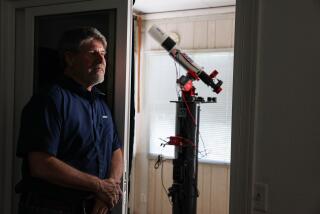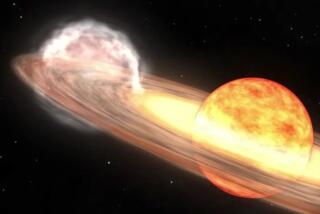SCIENCE / ASTRONOMY : Scientists Learning How Stars Explode : Researchers study supercomputer models of explosions. They discover that supernovas concentrate energy and propel debris in all directions.
TUCSON — The universe’s most violent event--the death and subsequent explosion of a star--has long perplexed scientists who could easily explain why the star died but were baffled by why it exploded. Now, thanks to a new generation of supercomputers, researchers believe they are far closer to understanding the dynamics of an explosion so powerful that it can outshine a galaxy of 100 billion stars.
Astronomers have found that the explosions--called supernovas--are far from the tidy, symmetrical events they believed them to be. Rather, the explosions concentrate energy in “contorted fingers” that send debris flying in all directions, said researchers who discussed their work before the American Astronomical Society on Monday.
“There are fingers and tendrils extending out like a monster coming out of a pit,” said University of Arizona theoretical astrophysicist Adam S. Burrows.
The breakthrough, as UC Berkeley astronomer Alex Filippenko called the findings, was facilitated by new computers that allowed researchers to model supernovas in two and three dimensions.
The results should help scientists explain one of the most complex events in nature.
All stars eventually die, but exceptionally massive stars frequently do so with gusto. The star consumes all of its fuel and collapses as its central core shrinks in less than a second from a diameter of 4,000 miles to about 20 miles. That exceedingly dense mass creates such a powerful gravitational field that all nearby matter is sucked toward it.
And that, common sense would suggest, should be the end of it. Except it isn’t.
Occasionally, said astronomer Willy Benz of the University of Arizona, a supermassive star explodes violently within a second after its death. For decades scientists have tried to understand why, but with limited success.
Their mistake, Burrows said, was to look at the explosion as a spherical event, like an exploding ball.
But that began to change in 1987 when astronomers discovered a nearby supernova in the Southern Hemisphere. That violent explosion gave them an extraordinary opportunity to rethink their ideas.
They recognized immediately that the 1987 event was not purely symmetrical because images of the supernova showed a lopsided envelope of debris and gas blasting off into space.
Using the supercomputers, they created multidimensional models of a supernova, showing what would happen immediately after the iron core collapsed.
“The sudden, near-millionfold compression of the core makes it fantastically hot, on the order of several hundred billion degrees,” said Marc Herant, an astrophysicist at Los Alamos National Laboratory who worked on the project. “It becomes a huge reservoir of heat energy.”
Gravity pulls surrounding gas toward the core, which has become so hot that it begins radiating energy as neutrinos, tiny particles that stream through the gas like bullets through air, Herant said.
The computer modeling showed that the cool gas, falling toward the core, would be stirred by the storm of neutrinos, creating extreme turbulence in the gas around the star, the scientists said.
The turbulence allows long arms of gas to fall toward the core, where it is bombarded by neutrinos and heated and expanded like trillions of hot-air balloons. The gas billows out from the core, carrying energy with it.
Until now, scientists had not realized that the gas had been so turbulent that it could capture enough energy to explode.
The scene, Herant said, is a little like a pot of thick soup boiling on a stove. If the pot is left alone, the soup on the bottom just burns. But if it is stirred, energy--or heat--builds up throughout the soup.
For a supernova, Herant said, it only takes about a tenth of a second for enough energy to be stored in the heated gas to generate an explosion that blows out the entire outer layers of the star.
“The whole thing is like a pressure cooker with no safety relief valve,” Benz said.
Burrows likened the explosion to a “fragmentation grenade” with the explosive power of 100,000 trillion trillion megatons of TNT per second--unlike anything else observed in the universe.






